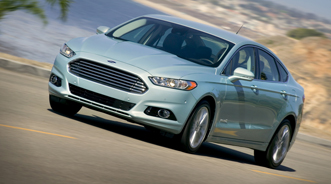Ford Recalls 2013 Fusion for Second Time

By subscribing, you agree to receive communications from Auto Remarketing and our partners in accordance with our Privacy Policy. We may share your information with select partners and sponsors who may contact you about their products and services. You may unsubscribe at any time.
WASHINGTON, D.C. –
While possibly not as immediately severe as a defect officials said might cause an engine fire, a National Highway Traffic Safety Administration alert said Ford is recalling the 2013 Fusion for the second time in less than a month.
The newest recall was triggered by affected vehicles that may not have had the low beam headlamp projector coating properly cured during its manufacturing process. Federal officials said Ford is recalling 19,106 units manufactured from Feb. 3 through Oct. 20.
NHTSA fears an improperly cured projector coating will become hazy through operation over time, reducing the brightness of the low-beam lamp. Officials said this condition may decrease driver visibility and increase the risk of a vehicle crash.
Ford told the federal agency it will notify owners, and franchised dealers will replace the headlamp assembly. The recall is expected to begin today.
Back on Nov. 30, Ford announced a voluntary safety recall of the 2013 Fusion SE and SEL models as well as the 2013 Escape SE and SEL models all equipped with the 1.6-liter engine.
Ford estimated that there were approximately 73,320 Escapes and 15,833 Fusions produced and distributed for sale in the U.S. and Canada with 1.6-liter engines, with most in the U.S. market.
Subscribe to Auto Remarketing to stay informed and stay ahead.
By subscribing, you agree to receive communications from Auto Remarketing and our partners in accordance with our Privacy Policy. We may share your information with select partners and sponsors who may contact you about their products and services. You may unsubscribe at any time.
Officials said the issue does not affect 2013 Escape or 2013 Fusion models with other engines.
Customers driving 2013 Escape vehicles equipped with the 1.6-liter engine and 2013 Fusion models equipped with the 1.6-liter engine were advised to contact their dealer as soon as possible to arrange for alternative transportation at no charge. Repair procedures are not currently available.
Ford is voluntarily recalling these vehicles because of reports of engine overheating, resulting in engine fires while the engine is running. No injuries have been reported.
Some drivers who have experienced high engine temperatures followed by engine fires say that their clusters have shown the message “engine power reduced to lower temps” or “engine over temp, stop safely.” Some also indicated that their instrument clusters sounded a chime and illuminated a red light.
The automaker said drivers who see any of these indications should safely pull off the road as soon as possible, turn off the engine and exit the vehicle. Ford said it will compensate owners for costs tied to overheating as well.
“We have identified an issue and are taking actions in the best interest of our customers,” said Steve Kenner, director of Ford’s Automotive Safety Office. “It is important that affected customers not ignore this recall and contact their dealer as soon as possible. While we recognize the inconvenience recalls cause our customers, we are taking these actions on their behalf to help ensure their safety.”
Ford said it is working on a repair procedure. When parts are available, the company will notify customers so they can schedule a service appointment with dealers.
Meanwhile, Ford is advising affected owners to contact a Ford dealer as soon as possible for alternative transportation at no cost to the customer; U.S. owners also may call (866) 436-7332 and Canadian customers also may call (888) 222-7814 for details on securing alternative transportation.
Customers can see if they are affected by the recall by:
—Checking their 17-digit VIN, located on a label on the driver door opening, at the base of the windshield on the driver’s side of their vehicle, or on their vehicle registration. In vehicles with 1.6-liter engines, the eighth character will be “X” on Escapes or “R” on Fusions;
—Logging onto Ford.com, click “View Notices and Recalls” in the “Support” tab and input their VIN to determine if their vehicle is part of the recall;
—Calling (866) 436-7332 in the U.S. or (888) 222-7814 in Canada
—Contacting a Ford franchised dealer
The OEM pointed out Escapes equipped with 2.0-liter and the 2.5-liter engines are unaffected. Fusions equipped with the 2.5-liter and hybrid engines are also unaffected — as are all Titanium models.
Officials Propose Broader Use of Event Data Recorders in Vehicles
In other NHTSA news, agency officials proposed a new standard that would capture what they believe to be valuable safety-related data in the seconds before and during a vehicle crash.
The proposed rule would require automakers to install event data recorders (EDRs) — devices that collect specific safety-related data — in all light passenger vehicles beginning Sept. 1, 2014.
“By understanding how drivers respond in a crash and whether key safety systems operate properly, NHTSA and automakers can make our vehicles and our roadways even safer," said Transportation Secretary Ray LaHood. “This proposal will give us the critical insight and information we need to save more lives.”
NHTSA estimated that approximately 96 percent of model year 2013 passenger cars and light-duty vehicles are already equipped with EDR capability. These devices are located in the vehicle and require special hardware and software to copy the information.
Officials explained a crash or air bag deployment typically triggers the EDR, which collects data in the seconds before and during a crash. The data collected by EDRs can be used to improve highway safety by ensuring NHTSA, other crash investigators and automotive manufacturers understand the dynamics involved in a crash and the performance of safety systems.
Examples of some of the information recorded include:
—Vehicle speed
—Whether the brake was activated in the moments before a crash
—Crash forces at the moment of impact
—Information about the state of the engine throttle
—Air bag deployment timing and air bag readiness prior to the crash
—Whether the vehicle occupant’s seat belt was buckled.
NHTSA pointed out EDRs do not collect any personal identifying information or record conversations and do not run continuously.
“EDRs provide critical safety information that might not otherwise be available to NHTSA to evaluate what happened during a crash — and what future steps could be taken to save lives and prevent injuries,” said NHTSA administrator David Strickland.
“A broader EDR requirement would ensure the agency has the safety-related information it needs to determine what factors may contribute to crashes across all vehicle manufacturers,” Strickland continued.
NHTSA went on to mention the new safety regulation would require EDRs as mandatory equipment in passenger vehicles that weigh less than 8,500 pounds. The proposal includes the same standardized data collection requirements established by NHTSA in 2006 for EDRs that are voluntarily installed by automakers (49 CFR Part 563) and mandates that automakers provide a commercially available tool for copying the data.
In keeping with NHTSA's current policies on EDR data, the EDR data would be treated by NHTSA as the property of the vehicle owner and would not be used or accessed by the agency without owner consent.
Members of the public are encouraged to provide comment on NHTSA’s EDR proposal and will have 60 days to do so once the proposal is published in the Federal Register.
The proposal and information on how to submit comments are available here.


